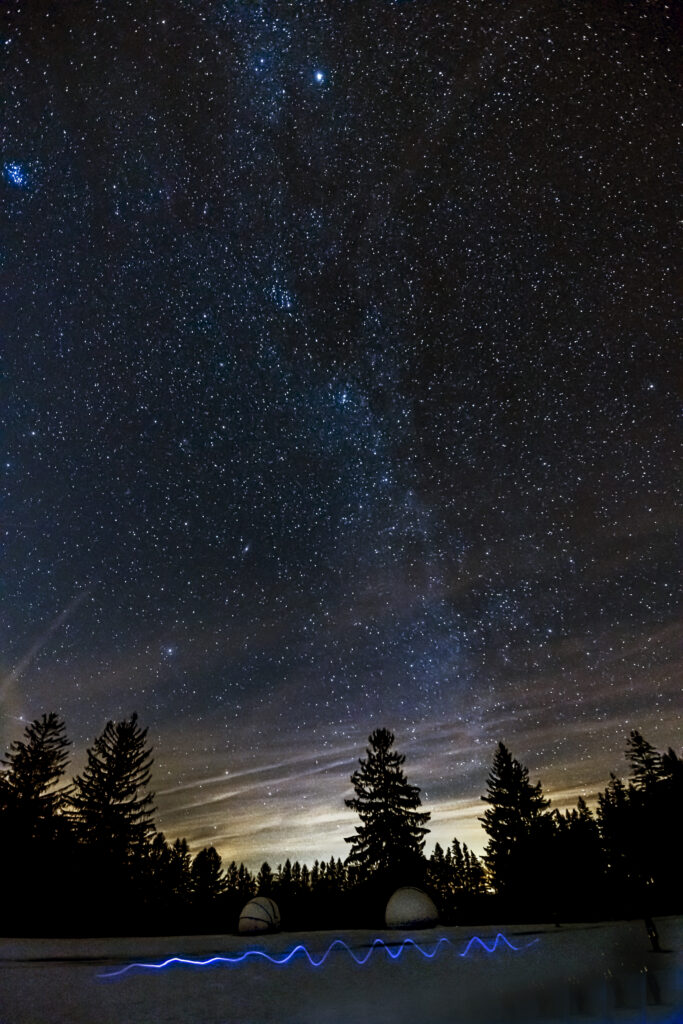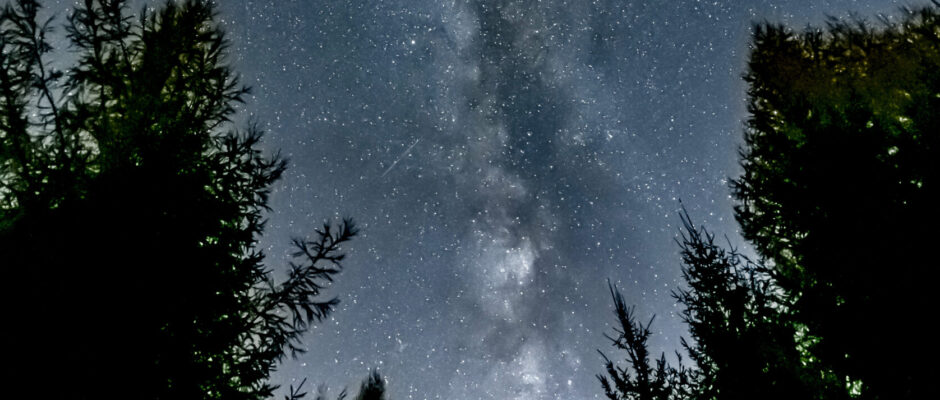“Before we invented civilization, our ancestors lived mainly in the open out under the sky. Before we devised artificial lights and atmospheric pollution and modern forms of nocturnal entertainment, we watched the stars. There were practical calendar reasons of course, but there was more to it than that. Even today the most jaded city dweller can be unexpectedly moved upon encountering a clear night sky studded with thousands of twinkling stars. When it happens to me after all these years, it still takes my breath away.”
– Carl Sagan
Curt Weinhold, a life-long resident of Pennsylvania and avid nighttime photographer, agrees with Mr. Sagan. Five years ago, he began offering classes on “Nightscapes” at Cherry Springs State Park. He loves introducing people to the wonders of the night sky.
“So many attendees have never seen the Milky Way,” he says. “[They] are astonished to see it, then even more so when it appears on a camera monitor. It’s an awe-inspiring moment.”
The PA Wilds is home to a region called the Dark Skies Landscape. The area, which includes much of Potter County and parts of McKean, Cameron, and Clinton Counties, offers some of the best stargazing in the eastern United States. The most spectacular area for night viewing is Cherry Springs State Park.
Nestled within the remote 262,000-acre Susquehannock Forest region of Potter County, the park was designated a “scenic area” in 1922, becoming a Civilian Conservation Corps (CCC) camp in 1933. Simple buildings were constructed, using local materials, to mimic the pioneer settlements of the Appalachian Mountains. Its current identity as a dark-skies mecca did not coalesce until the 1990s when the park began to attract the attention of astronomers — they spread the word that the site had a 360-degree view and no light pollution in any direction.
So many attendees have never seen the Milky Way. They are astonished to see it, then even more so when it appears on a camera monitor. It’s an awe-inspiring moment.Curt Weinhold
Not only is the park protected from artificial light by the surrounding forest, but it also sits on a plateau 2,300 feet above sea level where there is nothing to block the view of the sky. Every year, between 60 to 85 nights offer skies that are ideal for viewing. The nearest city is sixty miles away and there is very little commercial air traffic.
This means that prospective stargazers have access to conditions that are unavailable to two-thirds of the world’s population, including most folks living in the United States and western Europe, many of whom have never seen the Milky Way. In contrast, visitors to the park are able to see 10,000 stars with the naked eye under optimum conditions.
Considered a model site for night-sky viewing, Cherry Springs State Park has won numerous awards. In 2008, the area was certified as a Gold Level International Dark Sky Park by the International Dark-Sky Association, the highest designation available to a dark-skies site. In 2017 the park earned a PA Wilds Champion Award.
***

The Dark Skies Region is important as a tourist attraction, but it also plays a significant role in conservation efforts to protect threatened ecosystems.
In a National Geographic article on Dark Skies, writer Nadia Drake argues that the light bulb revolutionized our lives, allowing us to extend our waking hours far beyond sunset, but, “if light bulbs have a dark side, it’s that they have stolen the night.” Glance at a map showing our planet’s night skies from space, and you will see vast swathes of every continent in startling color. There is a growing body of evidence that what is now known as light pollution is disrupting the biological rhythms encoded in all life-forms.
Birds and insects are particularly affected. For insects, artificial lighting disrupts their feeding habits as well as reproduction and pollination. Migrating birds that navigate by moon- and starlight become disoriented, veer off course, and crash into night-illuminated city buildings. In other parts of the world, sea turtle hatchlings, dependent on the light of the moon to navigate their way across the sand and into the ocean, die when distracted by artificial light.
Dr. Heather Bechtold, Associate Professor of Biological Sciences at Lock Haven University, conducts research on the ways living things respond to environmental cues. One of those cues is light. Over millennia of evolutionary adaptation, plants and animals have developed mechanisms to respond to particular amounts of light, emitted at just the right times. Light pollution is throwing these mechanisms out of balance.
“Changes in light availability may alter an animal’s sense of space and location — for example they may confuse migration routes and feeding locations or pit stops,” she explains. “Too much light can alter behavior such as nesting, mating, and reproduction. Plants use strong cues from seasonal light availability, which signals timing for flowering, fruiting and seed set. Misreading environmental cues can have lethal consequences.”
Dark sky-compliant lighting will improve our nighttime vision, allow us to sleep better, reduce light distraction and glare, and allow the beauty of a soft, warmly lit scene to enhance our enjoyment of the evening.Diane Turnshek, Carnegie Mellon
And human beings are not immune. Our biological clocks have likewise been altered, our biochemical rhythms skewed. Repeated and prolonged exposure to artificial light produces low melatonin levels and disruption of our wake-sleep cycles.
More and more places in the United States are setting aside “Dark Sky Preserves” — areas that appeal to stargazers and support biodiversity. Here in Pennsylvania, cities such as Pittsburgh are taking bold action. The City Council recently passed a “Dark Sky Ordinance,” the first of its kind in the country. The ordinance will impact the lighting in all of the city’s parks and facilities. The city’s 35,000 streetlights will be replaced and up to 8,000 new ones will be installed. The technology — motion sensors, dimmers and timers, cooler temperature bulbs, softer light, and shielding (which makes sure light is directed down instead of up) — is approved by the International Dark-Sky Association. Similar initiatives are happening across the state, as detailed in a recent Keystone Edge story about making our cities more hospitable to migratory birds.
Diane Turnshek, astronomy instructor and special faculty in Carnegie Mellon’s Department of Physics, helped draft Pittburgh’s ordinance. She has been a dark sky advocate for ten years.
“The ordinance is about much more than astronomy,” she states. “Dark sky-compliant lighting will improve our nighttime vision, allow us to sleep better, reduce light distraction and glare, and allow the beauty of a soft, warmly lit scene to enhance our enjoyment of the evening.”
***
Cherry Springs Park is open year round and offers tech-friendly facilities for professional stargazers as well as free educational programs sure to delight the entire family. It’s the place to be if you want to see meteor showers, Aurora Borealis and, yes, the Milky Way.
Plan your trip now. The park’s camping area, open from April to December, has 30 camping sites that can accommodate tents or RVs, and its extensive trails host biking, snowmobiling, cross-country skiing, backpacking, ATVs and horses. To find a schedule of events, go to DCNR’s calendar and to learn more about dark skies, visit International Dark Sky Association.
We can all participate in efforts to create darker nighttime skies. Install motion detectors in your backyard rather than keeping porch lights on all night. Advocate for city lighting that uses “dark-sky compliant” LEDs. Volunteer to become citizen-scientists and collect night-sky brightness observations as part of the international “Globe at Night” campaign.
Anyone interested in learning more about how to photograph the night sky can sign up for a “Nightscapes” workshop here. Weinhold typically offers classes between April and October, and is willing to book private sessions (text 814-320-1857).
KAREN ELIAS, retired after 40 years of teaching college English, now works as a freelance writer and environmental advocate in Lock Haven. She recently completed training to become a Climate Reality leader and is using her writing to increase awareness of our precious natural resources and support for environmental sustainability.
LEAD IMAGE: Night skies at Cherry Springs State Park / photo: Curt Weinhold
This story was produced by the PA Wilds Center for Entrepreneurship and originally appeared on pawilds.com.
